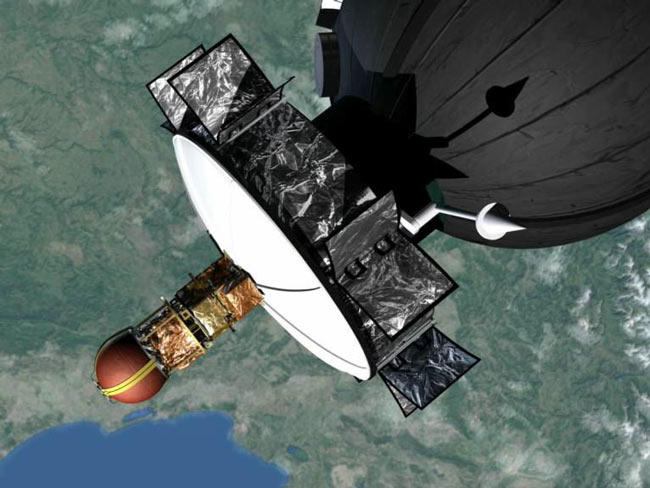Space Mail System Works (Except for that Lost Package)

Astudent-built satellite experiment shattered records by deploying the longestspace tether ever flown in space, but the missing return capsule remains amystery to unravel months later.
On Sept.25, hundreds of students worldwide watched remotely as a Russian-built Foton-M3spacecraft began unwinding a 19.7-mile-long (31.7 km) super-strong space tetherno thicker than a string. The experiment's small Fotino capsule dropped from ittoward Earth, preparing to release at the right moment for re-entry into theatmosphere.
The goalwas to demonstrate a"space mail" system of delivering packages to Earth usingjust a tether.
But theexperiment hita snag when critical telemetry sensors on the tether deployment mechanismshut down. That left the onboard computer unable to control how quickly thespace tether unwound from its spool. Early data suggested the tether reached alength of just 5.3 miles (8.5 km) before cutting the Fotino capsule loose.
"Wewere kind of disappointed by the fact," said Marco Stelzer, a missionanalyst and ground support engineer with the European Space Agency (ESA).
Steizerjoined the Young Engineers Satellite (YES2) experiment – sponsored by the ESAEducation Office – as a university student when he saw the tether idea promotedby Delta Utec SRC, a private space consultancy company that contracted withESA. Almost 500 students from Europe, the United States, Russia, Japan, and Australia worked on YES2.
Hoperevived
Get the Space.com Newsletter
Breaking space news, the latest updates on rocket launches, skywatching events and more!
New telemetrydata from the Foton spacecraft saved students from a mission cliffhanger,revealing that the space tether deployment had accelerated rather than slowingdown as first thought.
"Lateron, we found out that the tether deployed to its full length, even more thanoriginally planned," Stelzer told SPACE.com.
Additionaldata from the U.S. Space Surveillance Network showed that the Foton spacecraftmoved close to a mile higher in orbit when the capsule cut free – as expectedwhen a 19.7-mile-long tether's swinging momentum that launched the capsule alsotransfers to the much heavier spacecraft.
Where'sthe capsule?
Havingsmashed the world record for the longest man-made object flown in space, theYES2 team turned its attention to what happened with the Fotino capsule. Theonboard beacon had failed to activate and signal the capsule's final location.
"Wehave some confidence that the capsule actually came down," said Stelzer,pointing out that a full-length tether deployment would have released thecapsule back into Earth's atmosphere. A U.S.ground station in Alaska did not detect Fotino flyingoverhead after the tether release, also suggesting the capsule re-enteredinstead of continuing in a low-Earth-orbit with the Foton spacecraft.
?It mayhave burnt up on re-entry, it may have crash-landed, it may have touched downin difficult terrain somewhere in Turkmenistan, Kazakhstan or Siberia, or its radio beacon did not transmit," said RogerWalker, YES2 project manager for ESA?s Education Office, in a public statement.More information will come in the next several weeks from other experiments andsensors onboard Foton.
Whatever Fotino'sfate, the YES2 team cheered the test of the "space mail" deliverysystem using the space tether – even if the package was lost along the way.
"Weproved that tether technology actually works," Stelzer said.
Futurespace tethers might not only deliver parcels to Earth, but also swingspacecraft or satellites into different orbits or towards other planets.
The ESAEducation Office has additional satellite projects in development, includingthe European Student Earth Orbiter (ESEO) planned for 2010 and the EuropeanStudent Moon Orbiter (ESMO) planned for 2011.
- VIDEO: What Should Have Been
- IMAGES: 50 Years of Spaceflight: The Road Ahead
- All About Satellites
Join our Space Forums to keep talking space on the latest missions, night sky and more! And if you have a news tip, correction or comment, let us know at: community@space.com.
Jeremy Hsu is science writer based in New York City whose work has appeared in Scientific American, Discovery Magazine, Backchannel, Wired.com and IEEE Spectrum, among others. He joined the Space.com and Live Science teams in 2010 as a Senior Writer and is currently the Editor-in-Chief of Indicate Media. Jeremy studied history and sociology of science at the University of Pennsylvania, and earned a master's degree in journalism from the NYU Science, Health and Environmental Reporting Program. You can find Jeremy's latest project on Twitter.









